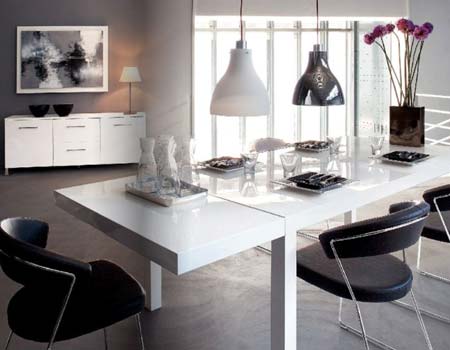Plan your dining area
The traditional dining room has been having an identity crisis of late. No longer is it the place for serving up meals daily - now it plays host to hobbies, homework, office work and, predictably, storage. Yet, as the room that’s dedicated to entertaining without a TV in sight, it's a valuable commodity and one which does that rare thing: guarantees quality time together. A planning challenge it may be, but one that’s certainly worth it.
Function and form
Consider whether your dining room will be used solely for entertaining or whether it will double up as a study/office or play space. If it has a dual function destiny keep the emphasis squarely on the dining and minimise the peripherals. House computer workstations within discreet storage systems or behind a contemporary screen and be utterly ruthless with paperwork (approximately 40% of all filing is outdated, so get shredding!) Pare down toy collections and pile them into matching baskets, chest or ottoman.
Easy access
Sunday entertaining for eight means plenty of dishes so plan your dining room with quick and easy access to the table. Make sure the doors and drawers of dressers and sideboards can open easily - there’s nothing worse than having to move a table to reach a wine glass! And if your dining room is a reasonable distance from your kitchen consider splitting your crockery and cutlery collections so a set is always close to hand.
Storage solutions
Insufficient storage, bane of the 21st century home, is a classic dining room faux pas. It’s easy to underestimate the capacity you’ll need for glassware, serveware, cutlery and linen, so if in doubt, go large. The traditional sideboard not only offers up tons of space but a handy surface for fresh flower arrangements and candles. If space is an issue, consider a corner unit or a slimline armoire.
Top table
All the action happens at the table so it needs to be the focal point of the room. The key decider here is size. If you love entertaining you’ll want maximum bums on seats but your table mustn’t be so big that your guests can’t push their chairs back. Drop leaf and gate leg designs offer the greatest flexibility but tend to be restricted to wood. If it’s contemporary steel, glass or stone you’re after, the capacity is fixed unless you create a larger table top specifically for entertaining. A large sheet of PG Bison Supawood or plywood can be covered with a tablecloth once in situ and stored in the garage when not in use.
It’s worth stating the obvious here: the large dining room demands a large table, but the small dining room is dwarfed by one. There are a few good rules of thumb in determining which size table to buy. Ideally your dining table should be no narrower than 90cm. Any less than this and you’ll struggle for central serving space. While you’ve got your tape measure out make sure there’s a minimum 120cm clearance from the back of the chairs to allow for traffic to pass comfortably. And work on the basis that each diner will need approx 60cm of space. Top tip: use a calculator!
Shine a light
The single overhead 60W bulb will do your dining room no favours (unless you're going for the gothic look!). For subtle bistro-chic hang pendants and chandeliers 60 to 80cm above the table to cast soft pools of illumination. Dimmer switches are an essential, particularly if the room is used for play and work as well as entertaining. Clusters of candles grouped together on table, sideboard or console table will add to the intimate atmosphere.

